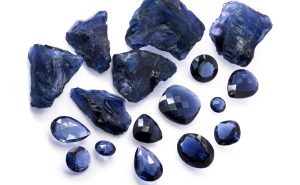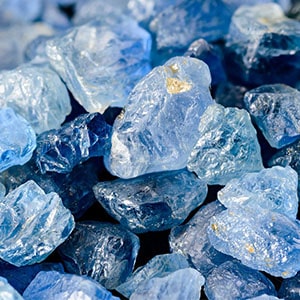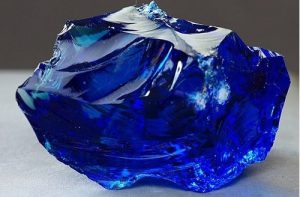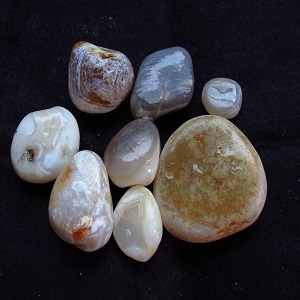Characteristics of sapphire stone

Blue sapphire is a stone from the corundum group with a high hardness of 9 on the Mohs scale and is the second hardest material in the world. The main mother stones of sapphire are basalt, marble, or all kinds of pegmatics. Today, in order to improve the quality of color and transparency in sapphire and ruby stones, they increase their value with the help of heating, so that a 5% improvement in the appearance of the stone increases its price by 25%.
The inherent characteristics of this stone, such as the double refractive index and specific weight, do not change with heating, but the two-color characteristic, optical absorption spectrum, and fluorescence change completely. The changes that occur in the impurities, such as the melting or expansion of the guest minerals due to their low melting point, or even the breaking of such impurities can help to recognize this method of improving quality, most sapphires and red rubies today They improve the quality.
The following table shows the characteristics of sapphire:
Table of characteristics of sapphire stone
Chemical composition of corundum – aluminum oxide with chromium – Al2O3:Cr
The color is usually blue, but it is available in different colors except red
Outline color without color
Clear to opaque transparency
No cleavage
Polished glass
Refractive index of light 1.778-1.762
Double failure 0.008
Hardness of the mouse 9
Specific gravity 4.06 – 3.98
Trigonal (hexagonal) crystal system
Fluorescence is not blue, but colorless, orange-yellow and purple ruby
The method of extracting sapphire stone

Most of the time, this mineral is extracted from sedimentary deposits or reserves that have been created by the destruction of primary mother rocks by natural factors (such as sun, heat and cold), and primary rocks are less exploited. Sapphire mining methods are separated by washing, clay, sand and gravel, but the final separation is done by hand. Sapphire is found more abundantly than its counterpart, ruby, and this is due to the presence of more of the blue coloring element iron than on earth.
Types of colors in sapphires
According to their impurity and location, sapphires have a variety of blue, colorless, orange, green, yellow, purple, and black colors, which are named according to their color, for example, yellow sapphire or black sapphire, etc. Meanwhile, sapphire is only called the blue type of corundum, and orange-pink sapphire is also known as Padparadscha.
The coloring element of the sapphire stone is iron and titanium, which produces a pure blue color. The purple color is vanadium. In fact, a small amount of iron in the chemical composition of this mineral creates yellow and green colors, and the chromium element also creates a pink color.
Blue: In Sri Lanka, there are lighter blue stones, mostly blue-violet with a shiny appearance, and in other areas of Cambodia (Pailin) and Myanmar, there are similar stones.
Blue Violet: Blue violet color is found in Myanmar and Sri Lankan sapphires.
Milky Blue: This color of sapphire is found only in Kashmir, India and Thailand. Due to the many tiny particles in them and the scattering of light by them, blue-milky sapphires are somewhat “sleepy” in appearance.
Inky Blue: Dark, blue-black sapphires usually come from Australia, Thailand, Nigeria, China, and Vietnam. They have excellent undertones and saturated colors, but their curtains are dark. Clear hexagonal bands are often characteristic of this gem.
Blue-green: This type of color is for sapphires with a little green color. Sapphires from Australia, Nigeria and some areas of Thailand may show this characteristic.
Sapphire cut

In general, sapphire sharpening is very good because of its high hardness. Polychromy phenomenon or pleochroism is also seen in sapphire stone and since the best color is in the direction of the optical axis, often sapphire gems are cut in the direction perpendicular to the optical axis. This is the reason why the cut of sapphire stone is wrong as the well-known cut of emerald.
In combined cutting, the crown plate and the pavilion are cut step by step. In Australian stones, because of the blue color, they cut a thin ink. Montana sapphire has a round brilliant cut. Cabochon cutting is often used in types that have a lot of impurities.
World famous sapphires
Coarse blue sapphire crystals are very rare and sometimes they are famous and named like the famous diamonds of the world. The Star Sapphire of India with a weight of 536 carats is the largest Star Sapphire kept in the New York Museum. A black gem of sapphire with the name Midnight Star and weighing 116 carats or Star of Asia 330 carats are also in the Smithsonian Museum in Washington.
Also, Edward Sapphire and Stuart Sapphire are two famous sapphire gems that are in the crown of England. The faces of the three American presidents, Washington, Lincoln, and Eisenhower, are engraved in three pieces of sapphire, each weighing about 2000 carats. The 423-carat Logan sapphire is one of the largest sapphires in the world. In 2009, miners in the Ratnapura region of Sri Lanka found an 880-carat sapphire the size of an egg in alluvium. Experts estimated its raw price to be more than one million dollars.
The largest sapphire in the world

In 1966, a 63,000-carat blue star sapphire weighing 12.6 kilograms was found in Burma, Myanmar. This crystal is the largest star sapphire in the world. As you can see in the photo above, to check if this whole piece is pure sapphire, the members of MGE company drilled a hole inside it with a drill and after confirming it, they bought it. It is interesting to know that in the beginning this piece was actually 40.3 kg along with other precious stones.
In 1995, in Madagascar, the largestThe world’s sapphire weighing 91,000 carats was found! After cutting, this sapphire was reduced to 61,500 carats, which will probably hold the record for the world’s largest cut sapphire and the world’s most expensive sapphire. Its name is Millenium Sapphire, which is valued at 50 million dollars.




